#with late 90s early 00s sci-fi aesthetic
Explore tagged Tumblr posts
Text
Humanity has reached the stars. Broken free of the confines of the Solar System, discovered other habitable worlds, and sent colony ships out to settle them.
But on one watery world, they discover we are not alone. The shuttles land, people step out onto a new landmass for the first time, only to behold ancient yet highly advanced ruins of a long-gone civilization. Ruins, and something else...
Ten years later, people have flocked to this world, dubbed Planet Sliplane. Pilots, mechanics, and engineers; using the technology discovered in the ruins to pioneer a whole new type of high-tech hovercraft, that can transform and shift as needed to adapt to any terrain. And what are they used for?
To race, of course.
Sliplane's many islands are covered in and connected by a vast network of radical racetracks, packed full of sick loop-de-loops and death-defying jumps, along with plenty of automated hazards. Here, racing meets exploration, as pilots of insane skill and radical courage are encouraged to test their talents by forging into the unknown, charting a course through the archipelago, and plumbing the ruins for valuable secrets. Can these ladies make a splash into this new frontier?
Of course, the best adrenaline rushes only come from the most intense danger...
S L I P L A N E
Coming Soon* to every console**
#not a reblog#sliplane#*probably somewhere between 'not for a long while' and 'never'#**probably just pc at most#RADICAL and not in the terf way#late 90s early 00s racing games#with late 90s early 00s sci-fi aesthetic#but with vehicular combat#and hot queer women as the playable characters#and a hopefully actually good plot#OH and a sick symphonic techno hip-hop soundtrack#this is my vision
26 notes
·
View notes
Text
Are We Returning To 2000s Era Shonen Anime/Manga (A Discussion)
So this is going to be way more of a thinkpiece than I usually do for this blog, but recent trends in the space and niche that I devote a lot of time to, Anime/Manga, have been showing themselves that got me thinking. This is not meant to be a serious sociology case study taken as fact, it's going to be more a theory based on observations of the community that I, like many others, devote a lot of time into than a full on claim, but I do want to ask, is the anime and manga community is experiencing a resurgence in 2000s era shonen manga?
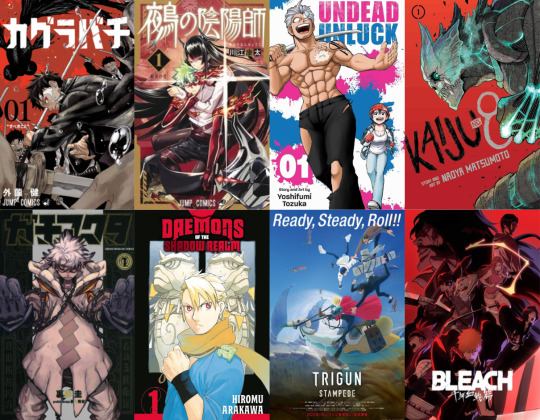
Background
Now let me get this out of the way, there is bias in these observations as I am a western anime fan, but also a North American anime fan. Meaning my gateway and gauges of pop culture are mostly determined by the history of my area of the world’s relationship with anime. From the OVAs of 80s hyper violent and hyper sexual sci fi that you had to purchase from the backs of video rental stores, to the Toonami era of 90s and early 00s programming block the centred around action anime and cartoons, the 4kids era of mass market japanese animated kids shows that were really just giant commercials with some of the earliest memetics in western sphere, and the explosion of shonen battle series in the western sphere in the mid to late 2000s marked by the rise of the colloquially named “Big 3” of shonen jump. I understand that continents like South America or Europe may have undergone a different exposure to the Japanese medium, but as I am going in with some bias in this observation, I would like to make it clear on where the formula is coming from. I also would like to lay down a certain clarification before making this, when discussing the topic of nostalgia I think a lot of people have forgotten what it actually means. If we go by the Cambridge dictionary definition, Nostalgia is “a feeling of pleasure and also slight sadness when you think about things that happened in the past.” This is often invoked when talking about pop culture because people from say 20 years ago don’t seem to enjoy or relate to the interests of today. The belief is that nostalgia is generational ergo if you grew up in the 80s you’re likely wishing to recapture the feelings of childhood that you associate with those trends from 20 years ago. In fact, most revaluation in media has often been catalyzed by a difference of those who grew up in an era rebuffing the opinions of those who didn’t.
There is the well known “20 Year Rule” regarding pop culture nostalgia. That every decade it longs for what was popular 20 years ago. Probably no better example than “That 70s show” being popular in the late 90s, the return of many beloved 80s-90s franchises like “Ghostbusters” returning in the 2010s as well as series like “Stranger Things” that wrapped itself up in 80s aesthetics. DC's New 52 relaunch that seemed to bring back trends from 90s era comics.
Now it goes without saying that the 20 year rule isn’t a “real” rule, rather an observation that certain trends make a return to popularity because the ones who grew up with a certain media will be the ones who add to the discourse when they come of age and will be the ones having a chance to create consumable art for the masses and that may just be revivals of once popular IP. This isn’t necessarily wrong in regards to nostalgia, but I do believe that one doesn’t need to have been born in a certain era to be nostalgic for something when we discuss pop culture. Pop culture is really just trends and preferences that become en vogue and people can acquire a taste at any given time. Sometimes it can be due to those who grew up with something now having the chance to create and drawing upon their own childhoods, sometimes it's just due to not being exposed, other times it can be a certain feeling of disillusionment of the now, and seeking something that peaks your interest, and even sometimes it can be major corporations or networks looking for things with existing audiences to draw upon that actually expand the audience. In fact one of the most prominent Netflix adaptations of the 2020s has been live Action Avatar the Last Airbender and One Piece, both shows that got their start on American televisions in 2004 and 2005. One of the biggest animated shows right now is Invincible, based on a comic book from 2003
So I want to stress this is not necessarily about how if you grew up with the original Mobile Suit Gundam show you are being replaced by the kids who were watching GetBackers. And or if you are a fan of shows that came out in the 2000s you yourself were born in the 2000s.
But what was the landscape of the English speaking anime community like back in the 2000s? Well let me paint a portrait for you.
What was the 2000s like for anime fans?
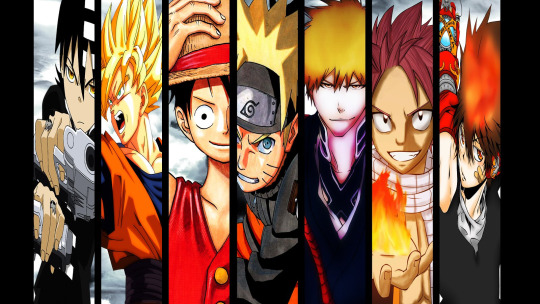
The term I used, “shonen boom period”, is somewhat mythologized in the western anime sphere. There was a glut of high profile shonen anime running around the same time that most people identified with this time period and was arguably when we saw the most influx of people getting into the hobby. One Piece, Naruto, and Bleach served as big series known for their massively large casts, MCs with a level of attitude, some of the most hype centric power supernatural/extraordinary power systems, and certain brand of “Japanese-y” humor. We can’t deny that it wasn’t just these series however, as series like Fullmetal Alchemist became many people’s introduction to more narratively intricate series interspersed with a somewhat gothic action style. The gothic and somewhat edgy Death Note became many fans' first ever “battle series that’s not a battle series” that also incorporated many biblical and gothic horror elements into its presentation. And things like Code Geass also incorporated this combination of hyper stylized cat and mouse with ornate and gothic aesthetics and fighting robots.
Series like Ouran Highschool Host Club and and Haruhi Suzumiya were basically gateways to the more hyper extraordinary slice of life series that didn’t shy away from fanservice and loud comedy. With ecchi like Rosario + Vampire taking it to an even greater extreme. For people willing to go even deeper, series like Fairy Tail began to pop up and share a distinct similar flavor to series like One Piece and Naruto which arguably started the popular conception of it coming from the same magazine as the latter. That’s not also discounting the amount of holdovers from the 90s like Dragon Ball z, Trigun, and Yu Yu Hakusho, which also had an edge towards fantastical combat and comedic oriented series.
All of this is to generally illustrate the media diet of what an average anime fan was expected to have some level of access to. As this was far before the eras of Funimation or Hulu having online services. Not a homogenized spread by any means, and im certain plenty of readers could name more underground or smaller series like Mushishi or Elphen Lied, but generally the popular mainstream you could tell that there was a consistent theme of long form media with a very loud, very flashy, and very action oriented type of series. Which I think is fair to say had skewed some people’s perception. And while I cannot claim with utter certainty that Japan was the same in this regard, you can look at magazines like Shonen Jump and notice a somewhat synchronistic trend. With series like Hitman Reborn, Gintama, D. Gray Man, Eyeshield 21, Bobobobo, etc.making a clear marcation of what was commercially successful at the time. Even series not inside the magazine but had smaller nicher, Tokyo-pop-esque series like Rave Master, Flame of Recca, Air Gear, History’s Strongest Disciple Kenichi, Soul Eater, etc all had a similarity to the shonen jump magazine. To the point it was not uncommon to see so many jump characters in a collage and one from shonen sunday or shonen magazine in there as if this was all coming from the same place.
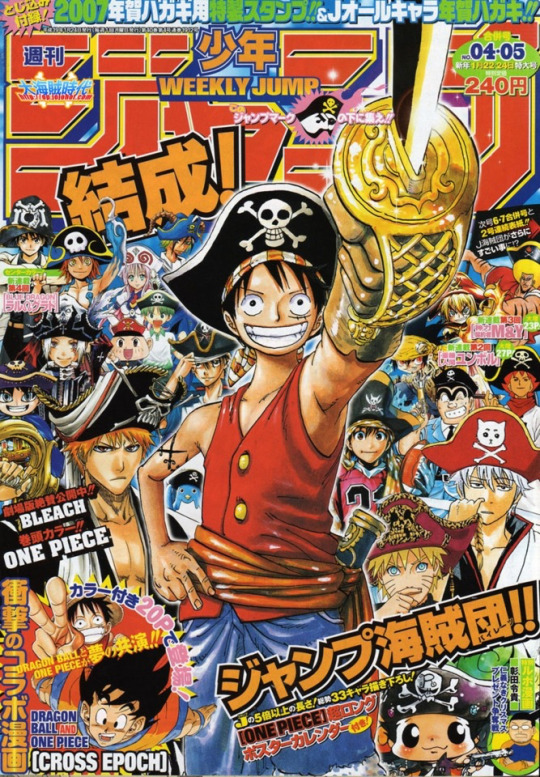
Changing Landscape
Now with the advantages of the modern internet, we have the ability to actually keep up with the jump magazine in real time as opposed to the common practice of relying on scanlation site and fansubs that were often devoted to the most popular works. But with simultaneous publication and services like Crunchyroll, being able to access a wider variety of shows and series that we may or may not have access to. I believe that the 2010s in the english speaking fanbase was the decade we saw a somewhat expansionism of what people perceived as anime. Anime could be One Piece and Naruto, but it could also be Erased, it could be the Promised Neverland, Attack on Titan, K-On, Haikuu, and Durarara. With the representatives of the 90s no longer being holdovers in syndication like dragon ball but rather full on revivals of the likes of Jojo’s Bizarre Adventure and Hunter x Hunter.

All of these could be "shonen" but also other genres like Seinin, Josei, and Shojo all had their own varying layers of what they could be in their demographic
The mood of what was popular was also changing, not just in the fact that more flavors of anime and manga were becoming mainstream, but new works from shonen jump showed a rise in almost subversive series like My Hero Academia and Demon Slayer that seemed to consciously deviate or place new spins from traditional tropes of the 2000s characters, and we saw works that were derivative of previous serious like Black Clover drawing upon Naruto the same way it was known that Naruto had drawn upon Dragon Ball before them. Series like The Promised Neverland and Doctor Stone offered up more dramatic series that still infused a certain energy of the shonen genre.
And of course the series like Attack Titan whose much more darker and gorey storytelling seemed to have become one of if not the biggest hit of the generation with a well regarded adaptation, but something that had felt so removed from what were once contemporaries like the then ending Bleach or Naruto. We can also note that the late 2010s saw the rise of series like Chainsaw Man and Jujutsu Kaisen that began a trend of popular urban fantasy stories. Where fantastical concepts were now in contemporary Japan and the stories that focused on concepts like self identity and the harshness of maturing were juxtaposed to the real world inhabited by monsters.
It seemed many tropes of the previous decade were still alive in the rise of Isekai anime. Which was particularly the only popular outlet for fantasy stories with an action orientation. But these almost felt disconnected from the wider world of manga as things like heavy harem action series had actually decreased in mags like shonen jump. There was also new tropes being established in this subgenre that became unique popularizations of tropes all on their own, such as the overpowered protagonist whose power everyone believes is weak. But many of these were based on light novels, a form of media that only in the last few years western readers are having official access to and not simply scans found on the internet.
We in North America truly have gone from anime being a niche that was primarily accessible through dedicated TV blocks like Toonami, to a full blown cultural relevance shift.
We also need to talk about this era in its perception of the past also shifted. The 90s and the early 00s often blend together as classics of the anime community. Somewhat encased in amber. However, there is no denying that “feels like a 2000s series” had become a bit of a shorthand for very goofy, Very horny, very action heavy series. Series like Fire Force and and Undead Unluck had their show what more problematic elements be equated to the problematic trends of the past that people just accepted as “a part of the medium.” But lets keep in mind, this is not really describing a time, more a trend. Superficial elements that invoke similar feelings of the past.
Speaking of anime fans…
Fan Culture
So while I wanted to paint a picture of creatively the landscape has changed, there’s no denying that in the age of internet accessibility, the anime fan community has also changed. It is much much easier now to get in contact with people who are anime fans now than it was to rely on word of mouth like it was back in the day. I can still distinctly remember my anime club which wasn’t even really a club devoted to anime but rather other geek stuff like D&D and TCGs. Our hobbies just happened to have similar overlap.
Now though, anime fan culture is much more relevant and thriving. Going from just posting weekly reviews, to long retrospectives, comedy videos, abridged series, clickbait articles, fan theories, and podcasts. However, I think a defining feature of fans of the 2000s era of anime that were at their most prominent was hype culture.
Due to many of the biggest anime series at the time being released weekly and focusing on action, many many many discussion boards and videos were often about staying in this cycle of wanting to see what happens next and the action made people very excited to see just how characters were going to win fights or even if they’d have fights at all.
I want to make it clear that this type of activity doesn’t belong to a certain era, but you can see it shaped by the 2000s era. Especially when discussing “what is the next big 3.” As if it were a true position and title, rather than a moment in time where there were just three very distinct shonen series in the fanbase.This doesn’t necessarily have a “negative” effect on the discussion of anime/manga but you can see that certain genres lend themselves to hyping fans up more and more.
Someone isn’t reading the most recent chapter of a romance like Blue Box with the same level of anticipation of who will face who like it was One Piece. But there have certainly been series that try.
The Present
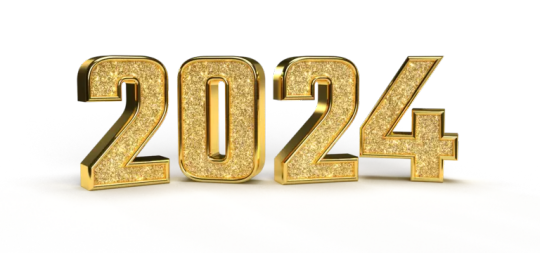
Now we reach the 2020s and this decade is still young, so it is hard to say what the future will hold for certainty, but we can look at the last four years and notice some significant waves being made recently in Shonen Jump alone. I already spoke of Undead Unluck, a series that almost wears it would now be considered retro inspirations on its sleeve. With an opening chapter that establishes an MC that seems motivated by a sexual joke, A power system follows a verbal naming gimmick, and a loose enough world that allows for characters of varying aesthetics and to be incorporated into groups. With groups of these powerful characters splitting up to face each other and use their ridiculous power to the extreme. Even in the series' own meta arc about creating manga, the in-universe analogy for Undead Unluck’s manga is commented on as feeling retro. There is no doubt the biggest viral hit of the decade so far has gone to Kagurabachi, a manga about sword fighting and magical crime lords that seems almost indulgent in its stylistic slicing and or dicing of baddies. Its memetic success was primarily due to a somewhat sincere and somewhat ironic belief that it would be the “next big thing” as it promised to be a stylized action series. Another surprise viral success has been the manga Nue’s Exorcist which sees another supernatural swordfighter boy harness the powers of his sexy spirit lady while getting into harem shenanigans that echo a particular form of ecchi of anime’s past that had actually been somewhat absent in the past decade in jump. Both of these series have a somewhat noticeable similarities to Bleach, a long running shonen action series that has seen its own revival in the last few years of writing this with the long awaited adaptation of the final arc of the bleach anime.
While the other members of the “big 3” never truly went away and became almost inter-generational, Bleach truly did feel like a “come back” as it was absent for so long. And unlike Hunter x Hunter and Jojo which were never really popular in the west and even their older anime are more regarded as anime deep lore. Bleach was one of the most popular series in the west at the time to never receive a conclusion animated.
Speaking of anime of the 2000s Trigun Stampede was a reimagining of the original late 90s show. This errs a bit similar to Hunter x Hunter’s style of revival, but also seems uniquely its own in actually trying to find a balance between the original series but adding in things cut from its original late 90s early 2000s counterpart.
And now we must examine other shonen magazines. Series like Gachiakuta created by a former assistant of Okubo, the creator of Soul Eater, carries with it much of the similar energies of that series. Its also noticeable as being a truly dark fantasy series. Not an urban fantasy, but rather a completely new world that had a very grunge and dirty world building. And then there is Daemons of the Shadow Realm, a series by Fullmetal Alchemist creator Hiromu Arakawa. This series is also set in modern day japan with supernatural elements, however Arakawa’s style of writing is practically unchanged from her time on FMA. With an emphasis on action, intricate mysteries, and character building comedy with her trademark over exaggerated blocky style. There is of course Hiro Mashima who has started another new series, Dead Rock, and his style has also not changed that much. Then there is just flat out sequels to 2000s series like Gamaran Shura.
This to me shows that we are seeing a bit of a combination of people who are now entering the workforce inspired by creators of the past, but also that creators of the past still exist 20 years later and are still making content that hasn’t really undergone significant change.
Of course, we can’t also forget the implementation of the Manga Plus/J plus service which has opened up a very interesting ground for creators to have some of the most creatively out there series than what you may have expected from the shonen jump brand. I genuinely don’t think series like Make the Exorcist Fall in Love or Fire Punch would’ve ever been acceptable in the pages of a weekly shonen series. However one series in particular does feel like it could've and boy its been quite the success. Kaiju no 8.
Kaiju no 8 almost feels as though it is the AoT of a new generation with the amount of anticipation this one series has as well as the similarities between the series superficial elements. However, I'd say the key distinction between the two has been the tone. AoT took a dark and practically dour tone on its titan infested world. With an MC declaring war on all of his enemies. The pain was realistic, with human bodies being brittle and vulnerable. And the belief that just because you were a good person you weren't going to make it out alive. Kaiju no 8 instead opts for a more action oriented tone. Down playing the bleak realism for more "Hell yeah!" moments. With super science weapons that feel more akin to a tokusatsu show and fights and battles between humans an kanji the feel like the Dragon Ball style wrestling matches of old.
And of course, that’s not to say Jump hasn’t continued with series that feel more modern like the realistic and mellow romance of Blue Box or the dramatic coming of age story of Akane-Banashi.
But the presence of these series has caused somewhat of a friction with the popular conception of the magazine. Its safe to say that while “shonen” tends to think of action male oriented series, it can really just mean works aimed more at adolescents. But I think many tend to associate this familiar feeling of “what is shonen” with their popular introduction of the magazine. With a saturation of action and brash comedy series. This is further complicated by the fact many action series in jump are actually ending over the last decade. With new ones not popping up to replace them as frequently and series like One Piece and MHA and Black Clover basically stretching out across an entire decade or longer. In fact, I don’t think it's unreasonable to believe that the hype for something like Kagurabachi was in part a belief that it signaled a return of a type of familiar series and genre that had been missing. Or at the very least, looked to fill an inevitable gap the magazine was obviously going to be facing. Followed by the other commercial success of Nue’s Exorcist, we are likely to see these series last for a long time. At the time of this writing, Tokyo Revenger’s author Ken Wakui has released Astro Royale, a series that feels very similar to his previous work yet infused with this almost GetBackers flavor.
So that leaves us with the question at the start, are we seeing a rise in 2000s nostalgia in anime and manga?
Conclusion
So I'm sorry if I disappoint, but the best I can say is, I’m not certain. I do believe that from my observation I think it is reasonable to say that we are seeing a rise in creators in the shonen space being ones inspired by series from 20 years ago. However, I think we are also seeing creators who are from that time period also returning to write how they have always written.
On the consumer side, I think we can see that fans of anime and manga have changed in the sense their tastes can now be shaped by a much larger catalog of series at their disposal. But in the case of shonen, I think we are simply seeing those who likely got their start in anime at around the 2000s resonating with newer series drawing upon those series, but also with younger fans now likely to grow up with the tail end of what was popular in the 2010s now being influenced by the 2020s. I also believe that one of the defining features of the anime community in the last decade is hype culture. And currently we are seeing a rise in series that actually feel more catered to hype, be it a revival of a series they liked or predicting what will be the next success.
All and all, this piece was trying to tunnel on the shonen demographic in general, which is more likely than not going to have similar traits relative to itself. I do see us as a community endorsing trends of the past and there’s an excitement for these things to “come back” even if they may or may not have left. If you liked this please drop a like or reblog because I may do more of these think pieces in the future.
#anime#manga#think piece#discussion#shonen#shonen jump#kagurabachi#gachiakuta#nue's exorcist#undead unluck#kaiju no. 8#bleach#one piece#naruto#yomi no tsugai#attack on titan
121 notes
·
View notes
Note
Thinking about writing teen Kick fanfic and I got very vivid ideas for the vibe but I am like so shit at outlining the plot and detailing it to late 90s-2000s tech cuz I was in the desert sand during that time
And since I love your aesthetics with the ghost boys, what do you think about;
Teen Kick:
owns a camcorder, takes it nearly everywhere he goes outside and enjoys making vlogs on tapes, mostly consisting of abandoned place explorations and attempts of paranormal activity caught on camera. (Marble hornets and analog horror inspired)
Obsessed with cryptids and critters, might not actually believe they're real but thinks they're such neat concepts and they're fun to talk about.
↑explains why he found himself exploring the woods and forestry around his mid-late teens
fascinated by weird sightings and loves recording shit to show off and ramble about to his friends, just passionate about his interests
Owns a flip phone or whatever good old fashioned cellphone during that time, would try to invite his friends over to go cryptid hunting, alien watching, or explorations w/ him
I'm stumped cuz I have a few stuff thatll be purely HCs like:
Nickname for him in his teenhood if Kick was his military callsign
Headcanon about which part of America he's from to pinpoint location and setting of the drabble
Tf happened in 90-2000s
Could you help me please🙏🙏 need headcanons<33 a lot of them
Ahh I love this idea! This all sounds so accurate for a fic like this. Teen Kick that takes a camcorder everywhere sounds so on brand, I can definitely see him having that ‘let’s go to this haunted/abandoned house…what do you mean why? Cause it’s fun’ energy lol. Alien/ghost hunting and cryptid sightings seem right up his funky alley.
As for his name/location, that can be difficult since you can literally make up anything you want lmao. But I like to hc him as being from somewhere around northeast USA that starts to teeter into the south, think Pennsylvania/New Jersey/West Virginia/etc. That would also explain his cryptid/alien/ghost loving behavior since there’s a lot of sightings and happenings in those areas. He gives me slight city kid vibes, but lived enough near the outskirts of whatever town to have been doing a bunch of rural exploring.
Since it’s implied that he’s a tech specialist for the Ghosts, I hc that growing up during the rise of technology was very influential in his career choices, and he probably spent a lot of time with stuff like this. I definitely see him with the camcorder here, and maybe a flip phone right around the turn of the century/early 00’s when they became popular. Probably spent a lot of time on some old clunky ass computer setup lol, gets flashbacks from the dial up internet sound like a true 90s kid. I think as tech kept advancing, he was always right on that shit, or at least he kept up with it.
Just some tidbits, but similar to Ghost/Simon Riley in the comics/‘09 Modern Warfare, I like to think maybe seeing 9/11 take place inspired his reasons to join whatever branch of the military he joined, seeing that as a teen would’ve def been very surreal, especially if he lived around that area. He also gives me big nerd vibes, was into all the sci-fi stuff around that time&prob played a lot of video games, had like a GameCube console or something lol.
Hope some of this helps! I love this fic idea and I hope you write it! <3
11 notes
·
View notes
Text
my biggest gripes with neocities is how a lot of people are adamant on holding onto the late 90s/early 00s geocities feel with starry backgrounds and endless anime and pokemon gifs plastered around with a bunch of ‘under construction’ buttons and vaporwave/sci fi aesthetic and rotating images of objects or whatever.... like more power to you but neocities gives you 1GB (a fuckton lot) to make your entire website for free and 50GB if you pay just a little bit per month and it gives you total freedom to make whatever the hell you want. ive been so many websites there that are completely different and unique from each other and its just sad seeing some people use their websites to just make yet another 90s space vaporwave aesthetic website. like i get it, it appeals to you, its an aesthetic you like, but that just makes you look so incredibly generic and forgettable in a website that lets you create ANYTHING with coding. youre just limiting yourself because you want to for no reason at all.
4 notes
·
View notes
Audio
Luar Domatrix - Nova Vida Passada - electronica from Lisbon with great variety of moods & beats (Domestic Exile)
Domestic Exile returns with the debut LP by Portuguese artist Luar Domatrix. LD has previously operated as 1/2 of Lisbon duo Yong Yong on Akashic Records and Night School, reworked traditional Portuguese workers songs for Discrepant Records, and released other solo material on Sucata Tapes, 12th Isle and Offshore Drilling Limited. Recorded between Lisbon and Glasgow, track 08 from the record 'I'll Fly With You' has featured on The Wire magazine’s Below The Radar 33 compilation as well as being supported by the likes of Jon K, Debonair, SIREN, Latete Atoto, SUE ZUKI and Body Motion on their respected NTS Radio shows. Bokeh Versions on Noods Radio and Vaj Power on Subcity Radio. ‘Nova Vida Passada’, which translated from Portugese means ‘New Past Life’, surveys the progressive expressions, technological innovations and futuristic aesthetics of late 90's & early 00's R&B, Hip Hop and Pop culture. NVP explores the way in which visionary songs of that nature can demonstrate being intimate and lavish but at the same time anonymous, intangible, enigmatic & metaphysical. Luminescent, glacial synthesisers merge with syncopated, multi-layered accelerated metallic percussion. Ebullient rhythms conjure up flourishing, intricate fractal patterns whilst euphoric, fragmented vocal edits gaze into a dazzling, psychedelic, precious crystal opal gemstone. How the moral sensibility of music is ever changing with the passage of time and propositions the listener to reflect upon the dynamics, ethics and desires of a generation. What does the ‘90s’ spirit epitomise? Music videos with abstract ice particle brick walls, gravitational fields, silver pagers, holographic iridescent spaceships, moral dilemmas and aluminium cyborg feelings. Pop music reverberating loud in a sci-fi celestial club in the distant future. Channels the same energies as Equiknoxx, NAAFI, Hakuna Kulala, BFDM and fellow Lisboners Principe.
2 notes
·
View notes
Text
The sound of cool: Shinichiro Watanabe and a contemporary dialog between Japan and America, pt. 2
While sipping a scotch, he nonchalantly smokes his cigarette. A saxophone swallows in the background. Can we call this “cool”? Let’s try with another example: sitting at the corner of a bar, he smirks as a group of yakuza threatens him; he smiles, as he is not threatened at all. A beat suddenly appears, and the fight ensues as he effortlessly defeats the yakuza. Now, is this cool? And furthermore, what makes it cool? Is it the attitude, the confident lack of preoccupations? Or – bear with me – is it the music?
Last time we discussed Watanabe’s work, we arrived at the connection that Cowboy Bebop (1998) has with American pop culture (specifically film noir). But, as we may suppose, anime is a complex artform, and style and aesthetics is only a part of what makes it great. So, let’s continue: what is so great – or dare I say, so cool – about Shinichiro Watanabe’s soundtrack decisions?
It all starts with the music
Several stories allude to the times when Watanabe and Yoko Kanno (Cowboy Bebop’s composer) were in the making of the series: a sort of synergetic creative flow inspired the young artists, and as Watanabe made characters and proposed ideas, Kanno suggested music to accompany the setting, and visceversa: as Kanno presented music to Watanabe, he created scenarios and worlds for it to be set.
For Watanabe, music does not serve the animation, but instead it complements and even is served by animation. Therefore, the chosen soundtrack will directly have an effect in the overall mood of the series, not just because music helps settle a mood, but because the music served as an inspiration for everything else that came after.
To further comprehend the effective and stylish nature of Watanabe’s sound, we first need to take a listen to two important collaborators in the music side of his productions: Yoko Kanno (Cowboy Bebop, Kids on the Slope, Space Dandy) and Nujabes (Samurai Champloo).
Yoko Kanno: in a realm of her own
Born in 1963, she started her career as a composer in the videogame industry with Koei during the late 80’s. She made her transition to anime in the early 90’s, when offered to work in Macross Plus (1994, 1995). It was during this project where she met a young director with a vision: Albert Einstein (no, I’m joking; it was Watanabe).
Only a few years later she would be involved once again with Watanabe, but this time in a project much more ambitious and personal: yes, I’m talking about Cowboy Bebop.
Recorded by The Seatbelts, this OST has become a monomyth of its own, and with good reason. Thanks to Watanabe’s taste and Kanno’s incomparable compositional skills, we got some of the most memorable and remarkable tracks in the realm of anime soundtrack: from the accelerating big band of the opening Tank! to the mellow and nostalgic guitars of Waltz of Zizi, musically its all over the place. But its variety doesn’t make it less cohesive; on the contrary, the compositional approach required this type of flexibility. Treating each episode as a self-conclusive story (with self-contained worlds most of the time) means that the aesthetics that can be evoked musically are diverse; and in that kind of freedom is where Kanno’s ability to adapt shines: from urgent ska in Bad Dog, No Biscuit to harmonica blues in Spokey Dokey, from beautiful rock pop in The Real Folk Blues to ethereal “space jazz” in Space Lion; truly, Kanno can do it all.
Nujabes: invoking the chill
The short life of producer Jun Seba (who went by his alias Nujabes) was marked by a prolific and impeccable work in the japanese hip-hop sphere during the 00’s (specifically in the world of sampling). Known by blending jazz and hip-hop aesthetics, he is considered a precursor of what we can hear today in lofi hip hop and chill music. Many contemporary rappers and producers still respect the legacy of Nujabes, to the point of comparing him to J Dilla (A famous american hip-hop producer from the 90’s).
The sounds of Nujabes reached the ear of Watanabe during the early 00’s, while producing Cowboy Bebop: The Movie. Thinking of characters to a new series, Mugen (Samurai Champloo’s protagonist) came to mind, envisioned as a “rapper samurai”. From then, and as its common in Watanabe’s creative process, the music came to shape the whole series: a blend of samurai movies set in the Edo era, and contemporary hip hop music and style.
We can see this exquisite blend most predominantly in the opening of the series. A mysterious but calm beat first sounds while the opening rolls in: Battlecry. Then, Shing02 starts to rap over the beat, from the perspective of a samurai and the world vision it encapsulates, narrating about honor, nature and the sword as central elements. All this while an amalgam of Edo-style animation and hip-hop aesthetics of the characters and settings appear in the screen.
And with this we can conclude the analysis of Watanabe’s work and its relation to American culture; a contemporary take to Japanese-American relations and a cohesive and stylish hybrid of both worlds: the noir and sci fi, jazz and space fights, hip-hop and Edo; the tradition and the future.
- Nicolás Iriarte Valenzuela
2 notes
·
View notes
Text
My aesthetic is late-90s through early-00s Canadian produced sci-fi shows. Andromeda, Mutant X, La Femme Nikita. Give me all of the 1.33 “state of the art” computer screens.
#aesthetic#canadian#canadian tv#canadian sci-fi#sci-fi#sci fi#sci fi shows#mutant x#andromeda#la femme nikita#90s tv#00s tv
61 notes
·
View notes
Text
Help, I can’t find this scene!
Okay, you know how sometimes you get a bit of a song in your head but it's too short to google the lyrics, so it just drives you insane until you stumble across the whole song again? For decades I have had that problem with a scene from a show or movie I saw as a kid that I have never been able to track down. I think I only saw these few minutes of whatever it was.
It was some kind of live-action horror/fantasy or (less likely) sci-fi, I think in a modern setting, and it would've been on TV in the late '90s/maybe early '00s. I just remember a female character, blonde I think, who was shaking while transforming into some kind of monster, and time was running out to reverse the transformation. The other characters managed to do whatever they needed to do just in time and she went back to normal, but in the meantime I think her eyes went really pale (maybe yellow) and she was growing fangs. I’m pretty sure there was a raised circular platform or fountain next to her, and her head and shoulders were flung back over the edge of it during this process. She might’ve had a white shirt on?
It definitely isn't Buffy, Angel, or Charmed, and I'm pretty sure I've ruled out Big Wolf on Campus. It might be Xena but that seems less likely because I feel like I would've remembered the decidedly not modern setting. I’ve had a look at a couple of episodes where Gabrielle gets possessed or turned into something and those don’t look right.
I'm also pretty sure it's not Forever Knight but mainly because there aren’t any blonde girls in that show. It does have a similar aesthetic to whatever the heck this scene is, though.
I was convinced it was Big Wolf on Campus for so long that I think I warped my own memory of what the character in question looked like. There is an episode where the blonde girl in that show temporarily turns into a werewolf, but no part of that episode resembles the setup I remember, and in general that show is way too light-hearted for something like this to fit in it.
Am I missing any other shows from that time period that it could’ve been? And I wouldn't even know where to start looking if this stupid scene was in a movie, except that it would have been a movie playing on TV during hours you'd expect kids to be awake.
Whatever this thing is, it stuck with me and it’s part of what sparked my interest in horror/fantasy stuff. (The other part is half of an episode of Buffy I saw when I was eight, but I DID figure out what that was years later, so I have to forever deal with knowing that baby me was so captivated by THIS
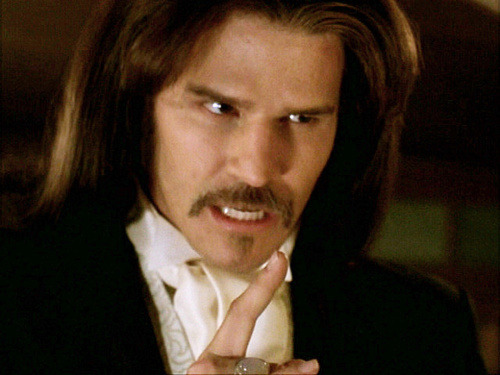
that I remembered the show for years until I was able to finally watch it. I mean I still love both Angel and Angelus, but mustache flashback Angelus? Really???)
Anyway, if you have any leads on the thwarted monster transformation scene I’m trying to find, please help.
0 notes
Text
Strange Days, 1995 - ★★★

A largely forgotten cyberpunk classic directed by Kathryn Bigelow and written by James Cameron. Like most of the sci-fi films of the late 90's early 00's, this film was both ahead of its time and has aged terribly. I'm not a huge fan of slimy Ralph Fiennes as I don't believe him or his nasally American accent (see Benedict Cumberbatch for more examples of this) and I'm also not hugely interested in any of the other actors or their performances. The cyberpunk aesthetic is a curious one; it's largely grounded by its location, but that also jars against the tech and some of the tone and the sets so it doesn't unify either in speculative distant future, or place us in the immediacy of near-future very well. Despite being lightweight, mostly purposeless (even though it tries admirably not to be) and thematically dated, the film is well made, made with talent and purpose, and a much more solid-a film than it is remembered as being.
source https://letterboxd.com/offworldcolony/film/strange-days/
0 notes
Photo
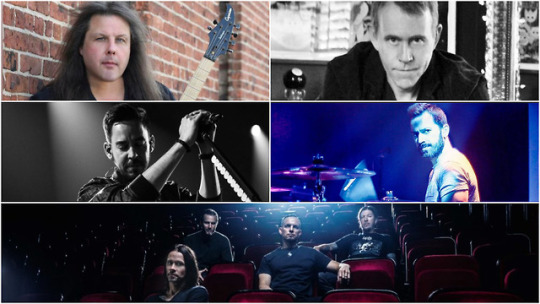
Jevnation’s top 5 albums of 2018
Kustin here, will be calling myself Jevnation from now on. Time passes quicker than most people may be aware of and as it shows, the members of IEH is certainly moving on to different, new things and interests (and names ;) ). But the love for music is always here to stay and it is in my interest to share my own list of top albums from last year that’s given aural pleasure and new sensations that helped enrich this year and the future to come. There are more albums that’s been on my mind and I’m likely to follow up with worthy mentions. But knowing me, I am a terribly slow writer trying to find words to express my experiences with the albums that crossed my life and ears. Hence this list being a couple of months overdue...
Without further ado, I present to you my top 5 albums in no particular order. Perhaps you’ll find some new gems to check out...!
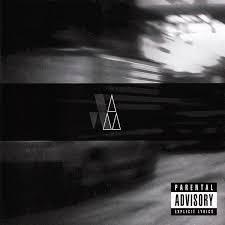
Cardhouse - City Blur Genre: Electronic/alternative rock The Liverpool band Anathema is seeing evolution and re-invention of their sound constantly, flirting more with modern electronics that graced their recent albums lately. Their current keyboardist/drummer Daniel Cardoso has fit well into the band's current formation and played competently in live shows though his apparent, creative mindset wouldn't be showcased there as much as it would show in his own debut, solo record he produced. Enter, Cardhouse! (I see what you did there, Cardoso)
The music in it is tricky to categorize but does deliver its own thing; a unique combination of alternative/indie rock with modern, electronic production and a dark, aesthetic foundation for the album. Cardoso handles all the instruments and programming that's well calculated yet sounding so unchained. (Yes, he did the Elvis cover here, too)
His crooning vocals go around the mid-high register, which adds to the melancholic value of certain songs but also belts out some yearning tones that adds some weight to the music. The vocal production is also enhanced by applying light pitch vibrato reminiscent of Daft Punk and distortion for intense moments, respectively.
Overall, City Blur is an engaging journey through the nocturnal soundscape that's defined by the electronic-rock hybrid and I anticipate a continuation of Daniel's creative, solo outputs in the near future.
Stand-out tracks: Ink, Forgotten, Monster.

Michael Romeo - War of the Worlds Pt. 1 Genre: Progressive power metal, Symphonic Metal Symphony X is going low since they released and promoted their latest album Underworld, leaving the members to pursue other projects while recharging. The classical-influenced axeman Michael Romeo, however, channels some of the 'X to his solo project, orchestrating new music while taking in other influences and musicians on board. They all fit like a glove together while the fresh singer John Castellano delivers nicely the melody lines, having the timbre and attitude of Kelly Sundown and occasionally reaches up the raw power of Russell Allen.
The record is a sci-fi concept album about the tense relationship between man and machine, making for a blending pot between metal, orchestral music and electronic music at some point. The Symphony X fans will rejoice to the band still sticking to the familiar songwriting, as much as I got instantly engaged in the first half of the album featuring tight songwriting, virtuoso musicianship, memorable hooks and meaty riffs.
Some curve-balls are thrown in, most prominently in the track "F*cking Robots", which I could describe it as a call-and-response between man and machine riding on EDM-metal crossover. Overall, the record had me blown away so here's to hoping the 2nd part holds candle to its predecessor, which might see the light of day this year or next.
Stand-out tracks: Fear The Unknown, Black, Djinn.
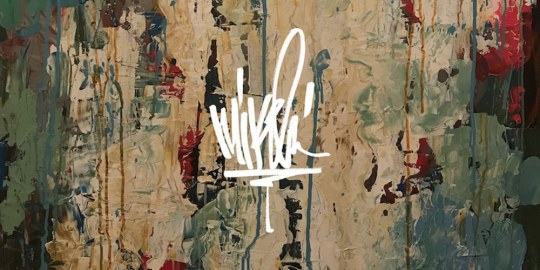
Mike Shinoda - Post-Traumatic Genre: Alternative hip hop, rap rock, alternative rock Following the tragedy that has befallen Linkin Park regarding Chester's suicide led by depression, the fellow band members have decided to take a hiatus in order to cope with their terrible loss. Whatever happens to LP remains uncertain by this day but Mike Shinoda has decided to write his difficult experiences and laments, after losing his close friend, into his solo rap album.
As it's a less common genre in my musical taste, Post-Traumatic is a mixed bag of musical elements embraced in Mike's recognizable rapping and songwriting akin to Linkin Park. The songs mainly contain electronics and sample-based beats but there are some rock music implemented in the album. Mike's lyrical deliery walk a fine balance between clear re-telling and poetic expressions, for the listeners to get a share of his states of mind throughout the griefing period that led into this album's production. There's also a handful of songs that feature guest artists that make fine contributions without taking over.
Post-Traumatic is an emotive concept rap record that is pretty dark and honest to its subject matter, with a vulnerable and cathartic side as presented by the LP vocalist, musician and producer. It was surely a difficult record for Mike to put together; the results show how he went through terrible times but forges on as a musician and living person.
Stand-out tracks: Over Again, Lift Off, I.O.U.

Phideaux - Infernal Genre: Progressive rock (Crossover) The wait has been long and Phideaux Xavier finally shows he's still around in the music world, juggling between his jobs as a series director (General Hospital) and his solo prog rock band. The previous album was released in 2011 but seeing that his band's trilogy had yet to finish their concept album trilogy that started with The Great Leap (2006) and Doomsday Afternoon (2007), the time finally came for them to wrap things up after 12 years of waiting. The fans could rejoice for Phideaux's return, as the years of teasing are finally through.
With plenty of materials to go by, Infernal is a double-disc album that follows the musical blueprint similar to Doomsday Afternoon and their recent albums, comprised from mainly 70's progressive rock, chamber music, neo-folk, psychedelic and gothic rock. This results in the decet (10 members!) band going on their adventurous mix of musical ideas that make every song stick out in their own way, characterized by their familiar use of mixed vocals, instrumental effects from modern and early technologies as well as a rich variety of vintage synth sounds.
The concept theme carries on towards its conclusion, touching more upon the dystopic science fiction that concerns a "Big Brother"-like society and ecological disasters. The tracks flow together and contain many cross references, lyrically and musically, that connect them within Infernal and the previous albums.
By the release of this final part of the trilogy being a fact, not only is it welcome for the fact that Phideaux can now put his mind to rest and move on with new, creative ideas but that Infernal showcases the band I've grown to love playing on a strong note as ever.
Stand-out tracks: The Sleepers Wake, The Order of Protection (One & Two), Tumbleweed
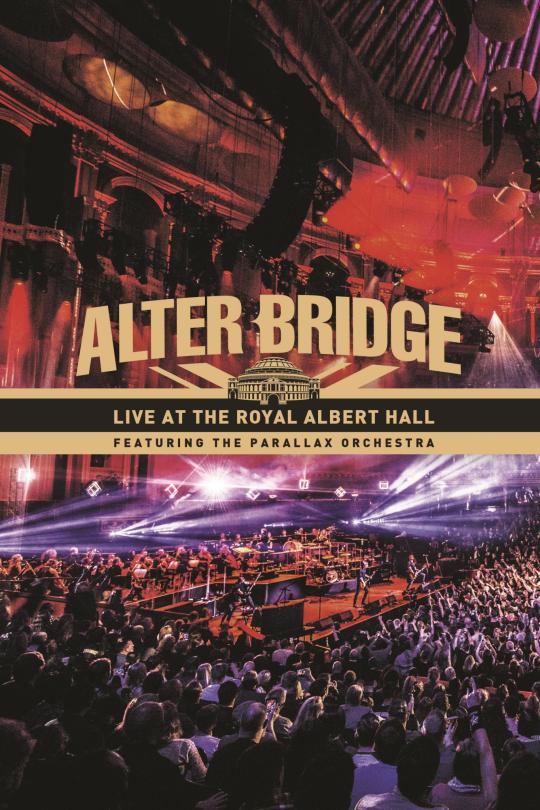
Alter Bridge - Live at the Royal Albert Hall Genre: Alternative metal, Hard rock, Symphonic rock, Post-grunge Live albums don't merit easily in the top lists as much as studio albums, so they have to contain something exclusive enough for a listener to buy it along with the studio album (regardless if they're playing your favorite songs in it or not). But a trend has been growing with rock bands doing live concerts, which is adding extra section musicians or even a full orchestra to add to the band's musical performance. The 90's had Metallica realize "S&M", Dream Theater made "Score" a reality in the 00's and this decade had a decent amount of progressive bands perform in Plovdiv, where a local orchestra has made a niche in augmenting the bands' classics with classical instruments (pun intended). It's probably no wonder that Alter Bridge would follow suit and do their own live take with an orchestra; an idea sparked by their manager that stuck fast and came to fruition.
Their setlist include tracks from every album released before-hand and don't shy away from songs that may have been played less live, on the principle of how well they fit with the orchestra. The best example would be "Words Darker Than Their Wings", which gives a more soaring air combined from the musical elements of epic rock and symphony. The heavier songs gain more dramatic weight delivered through while the balladic tracks are brought out in new shine, well worth hearing in Alter Bridge's both sides of spectrum. There's some behind-the-scenes footage coming up between the songs, which I find helps make a good connection with the viewers and fans to see the process that lead to the band's historical show.
For fans and new listeners alike, I'd proudly call "Live at the Royal Albert Hall" their go-to live album for the diverse yet accessible setlist and the orchestral addition to their music.
Stand-out tracks: Blackbird, Words Darker Than Their Wings, In Loving Memory
#top2018#Top Albums#progressive rock#Progressive Metal#Power Metal#electronic rock#alternative metal#alternative hip hop#heavy metal#alternative rock
0 notes